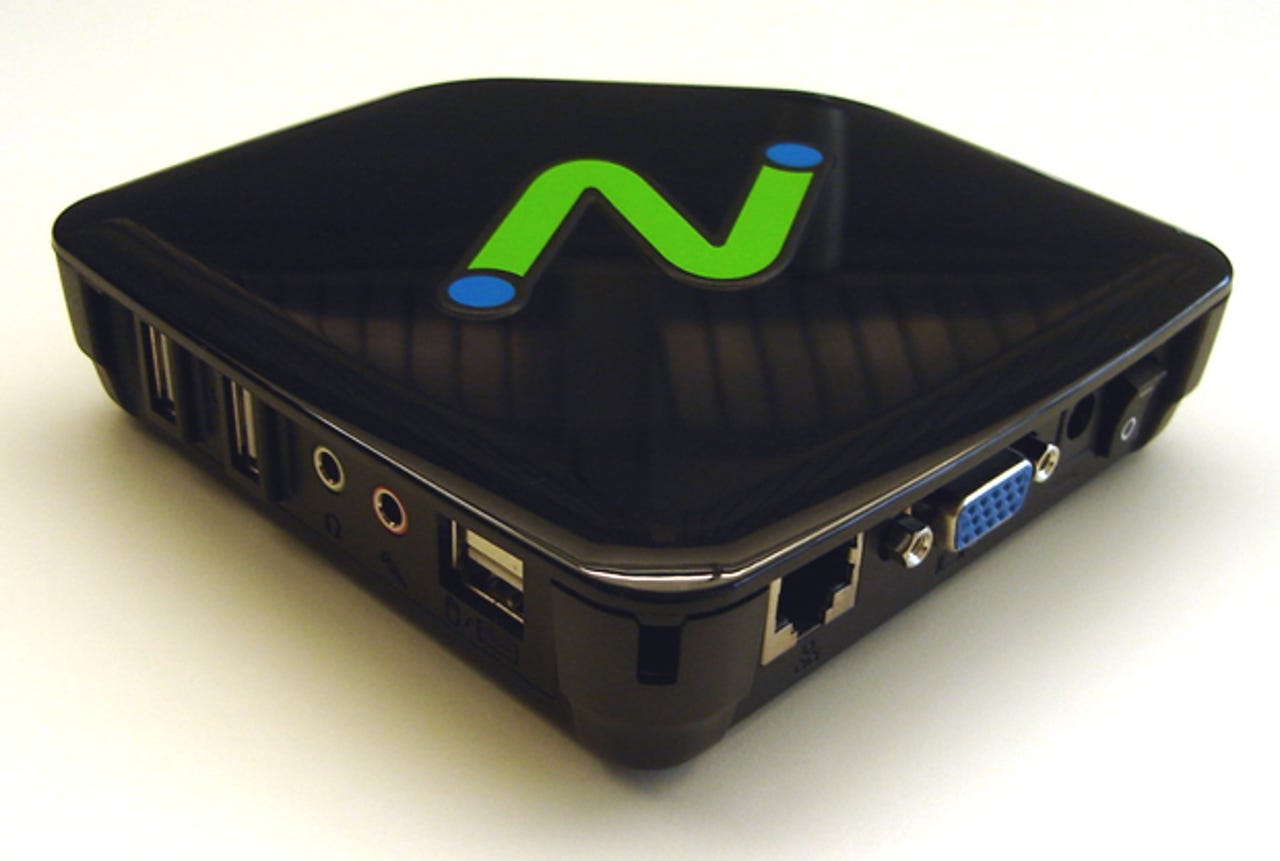NComputing L300

NComputing L300
Launched in April, the NComputing L300 is a zero-footprint thin-client for small and medium-sized deployments. Rather than rely on a hypervisor such as VMware ESXi or Microsoft's Hyper-V, the L300 is designed for use with NComputing's vSpace software to provide Terminal Services-style desktops for LAN-based users.
The L300, which has an 11.5cm-square foorprint, has a good set of connections for a thin client: 2 x USB 2.0 (for peripherals); microphone and headphone; 2 x USB 1.1 (for keyboard and mouse); 10/100Mbps Ethernet, VGA, 12V DC in, on/off
vSpace can be installed on servers running 32-bit versions of Windows Server 2003 and 2008, and Ubuntu Linux. If you're using Windows Server 2008 R2, you'll have to wait until Q1 2011, when NComputing will include 64-bit Windows platform support with the launch of version 6 of its vSpace virtualisation software.
We installed vSpace on a server running Windows Server 2003 R2. vSpace does not require Microsoft Terminal Services or a Microsoft Terminal Services License Server to be running, which makes the server-side setup straightforward.
In contrast to enterprise-level VDI systems, the price structure for NComputing L300 is also refreshingly simple. You buy as many L300 client devices as you want, and NComputing's vSpace management software and all software updates are free. Prices for the L300 hardware start at £180 (ex. VAT), with discounts available for bulk orders.
NComputing's (currently 32-bit only) vSpace software provides Terminal Services-style desktops for up to 30 LAN-based L300 users per server or host PC
To install and roll out applications, you use much the same process as Microsoft Terminal Services: that is, a server administrator installs whatever apps are needed on the server, and provided the apps work properly in a Terminal Services setup, they will immediately become available to users.
For example, we installed Skype on our server and as soon as the installation was complete, a new Skype icon was automatically added to our L300 users' Windows Start menus.
Adding a new L300 to your LAN is as simple as plugging it in. The device will get its IP address from a DHCP server, and will automatically discover any vSpace servers on the LAN. Something to bear in mind when adding or relocating users is that although NComputing describes the L300 as a zero-footprint client, it does actually contain some firmware and can hold some user preference data.
We found the L300 took around 40 seconds to boot in our tests. Depending on how the L300 is configured, on boot-up the user will either be automatically connected to their chosen vSpace server or they will see an on-screen menu allowing them to enter their Windows username and the server they want to connect to.
In our tests we simply created new users on the Windows Server and added them to the Remote Desktop Users group. This workflow is somewhat simpler than the equivalent needed to add a new user to a full VDI environment.
Administration on the server is carried out using the vSpace Console, which is launched by double clicking its icon in the Windows System Tray and entering a password.
Based on the familiar Microsoft Management Console architecture, the vSpace Console is easy to navigate. For example, we could expand hierarchies such as Hardware Settings to get a list of client devices, and adjust settings for individual clients using the device's Properties screen.
"="">earlier L-series devices, the L300 is designed to make more efficient use of LAN bandwidth and deliver better multimedia performance. According to NComputing, the L300 uses around 33 percent of the LAN bandwidth compared to the older L230, and consumes 5Mbps of LAN bandwidth to display high-definition video. In our tests, YouTube videos were rendered very well by the L300. We were also pleased to find that both of the L300's analogue audio sockets worked properly in our Skype tests. This may seem trivial, but getting microphone support to work properly in hypervisor-based VDI setups can prove challenging in all but the most high-end environments.
The L300 has a pair of USB 2.0 ports so users can attach peripherals like flash memory keys. The additional processing needed to transfer data from USB storage to the vSpace server meant we could only achieve a maximum of around 10Mbps bandwidth from these USB ports. If security policy demands it, there's an option in the vSpace management suite to disable the USB ports on selected L300 devices.
As far as pricing is concerned, the L300 compares very well against traditional thin clients running an embedded version of Windows, such as the HP t5730w, but is in much the same ballpark as other zero-footprint thin clients, such as the Pano Logic Pano System. However, the very simple server setup and easy management make NComputing's solution much easier to set up and run than something based on a hypervisor or full-blown Terminal Services.
You could also use the L300 with an enterprise-grade virtual desktop infrastructure (VDI) system such as VMware View. However, this configuration doesn't play to the L300 strengths of low acquisition and maintenance costs, and simple server setup for Terminal Services-style apps. In a VMware View setup, each L300 would be connected to a specific virtual machine (VM), and each VM would need to be individually configured with vSpace and the user's apps. You wouldn't have the benefit of a connection broker, but this kind of setup might be a good way to support a handful of people who use apps that don't work in a Terminal Services environment. NComputing expects to release a firmware update for the L300 later this year that includes a VMware View client.
